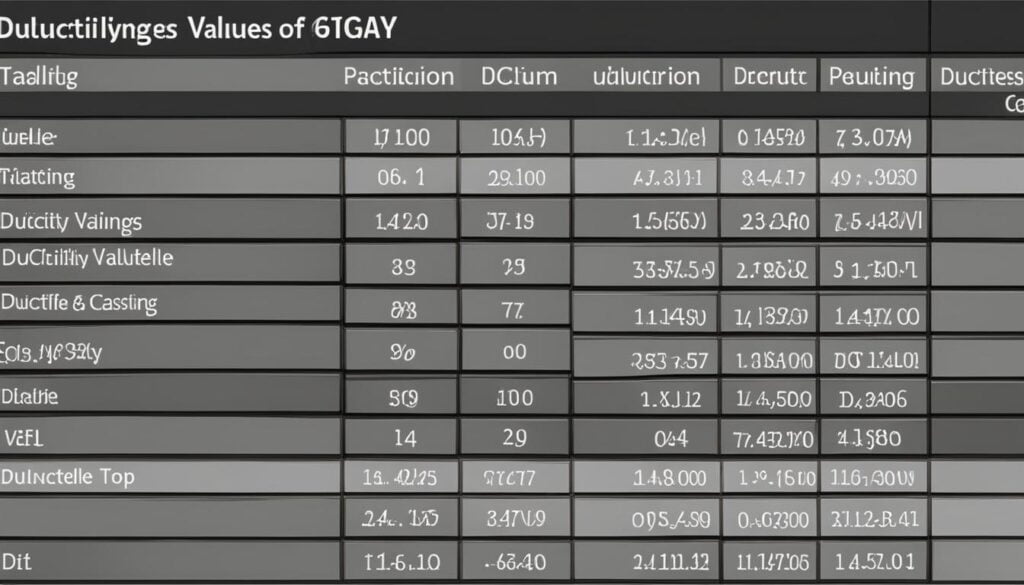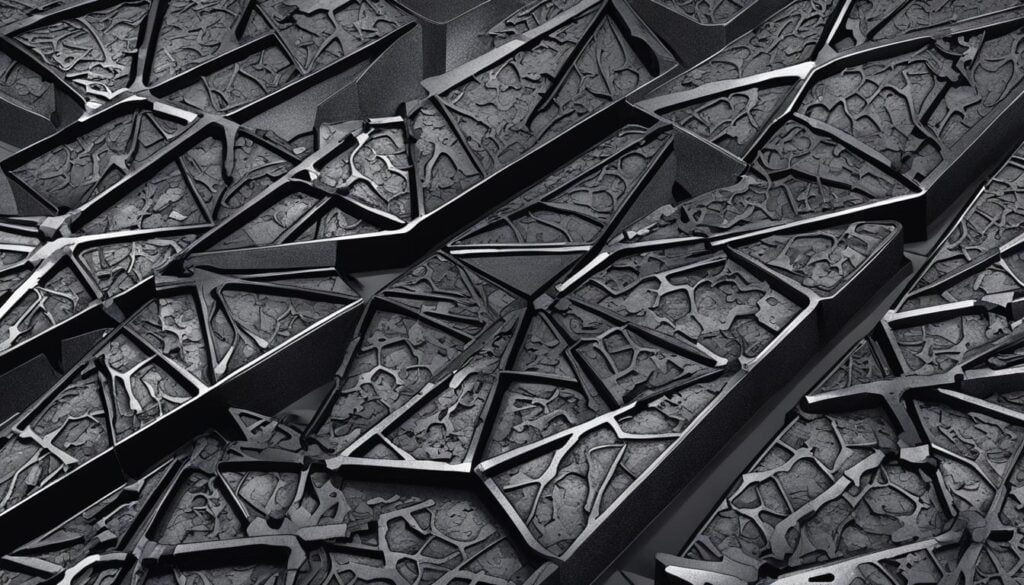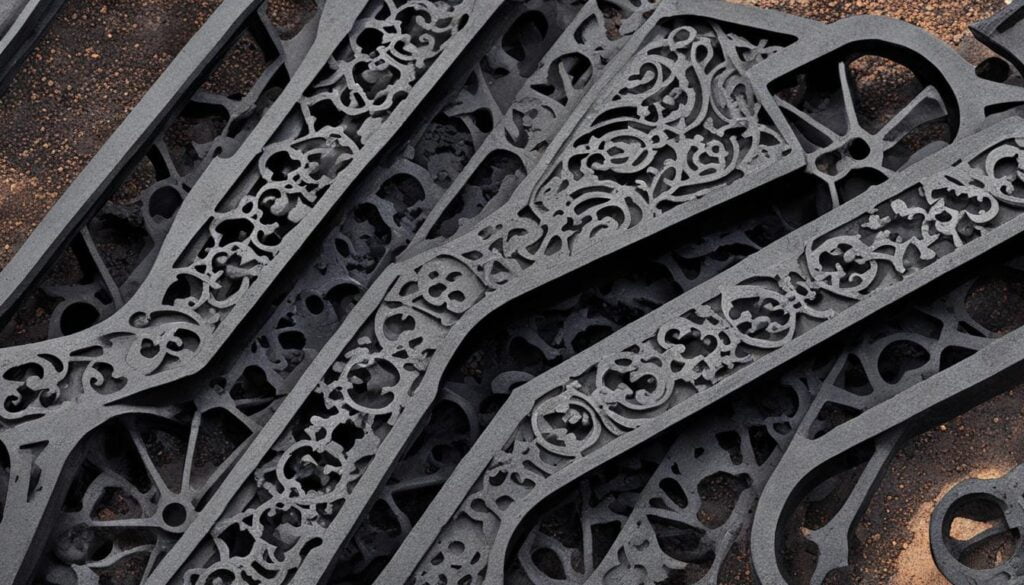At KT-Foundry, we recognize that the distinction between gray iron and ductile iron revolves around carbon’s structure within the metal. Gray iron’s graphite flake structure contrasts with ductile iron’s nodular graphite, influencing the materials’ ductility and toughness. With ductile iron offering high tensile strength (65,000 to 80,000 psi) and shock resistance (minimum of 7 foot-pounds of impact resistance) and gray iron providing superior vibration damping and thermal shock resistance due to its higher thermal conductivity, our understanding of these properties informs our expert selection for various applications, ensuring optimal performance of the castings we produce.
Key Takeaways
- Ductility and toughness differentiate gray iron from ductile iron.
- Carbon structure affects a casting material’s properties such as tensile strength and impact resistance.
- Gray iron provides excellent vibration damping and thermal shock resistance.
- Ductile iron has high tensile strength and shock resistance, making it ideal for specific applications.
- Understanding material properties is crucial in selecting the best iron alloy for specific applications.
Understanding the Distinct Characteristics of Gray Iron Castings
Gray iron castings exhibit specific characteristics due to their unique composition and structure. In this section, we will delve into the role of carbon content in gray iron and ductile iron, the different graphite structures, and compare their tensile and yield strengths. Understanding these differences will help us utilize these iron alloys effectively for various end-use applications.
The Role of Carbon in Gray Iron and Ductile Iron
Carbon content plays a significant role in determining the properties of both gray iron and ductile iron. In gray iron, the carbon exists in the form of flake graphite, while in ductile iron, it is present as nodular or spherical graphite. These graphite structures significantly impact the mechanical properties of their respective iron alloys.
Understanding Graphite Shapes in Iron Castings
Different graphite shapes in iron castings have a direct influence on the material’s overall properties. The flake graphite structure in gray iron results in lower ductility compared to the nodular graphite found in ductile iron, which offers higher ductility. This discrepancy in ductility is due to the presence of magnesium in ductile iron, which promotes the formation of spheroidal graphite.
Assessing the Tensile and Yield Strength of Gray Iron
Gray iron exhibits a range of tensile strength values, generally falling between 20,000 psi and 60,000 psi. This variation is mainly because of the diverse flake graphite structures present in gray iron castings. Interestingly, gray iron does not have a measurable yield strength, unlike ductile iron. Ductile iron is known for its higher minimum tensile strength of 60,000 psi and yield strength of 40,000 psi, which can be attributed to its nodular graphite structure.
At KT-Foundry, we leverage these differences in carbon content, graphite structure, tensile strength, and yield strength to engineer iron castings specifically tailored for a variety of mechanical properties and end-use applications. Understanding these distinct characteristics assists us in providing high-quality castings for a diverse clientele.
The Impact of Ductility in Iron Castings
Ductility plays a crucial role in iron castings by affecting the material’s ability to elongate under tension without fracturing. Ductile iron, with its nodular graphite induced by magnesium, exhibits superior ductility—achieving elongations of 18% with specific ASTM grades—over gray iron’s flake graphite composition. At KT-Foundry, we take advantage of this property for engineering specific parts that require flexibility and elongation, allowing us to tailor our products to the demands of critical applications.
Elongation under tension is a significant factor in determining the suitability of iron castings for various engineering applications. Higher ductility means that the material can withstand more strain and deformation without breaking, which is particularly advantageous for components exposed to dynamic loads, vibrations, and sudden impacts.
Iron casting ductility is an essential property to consider when selecting the appropriate material for a particular application.
To elucidate the differences in ductility between gray iron and ductile iron, we present a table comparing the minimum percentage of elongation offered by different ASTM grades of both materials.

| Material | ASTM Grade | Minimum Elongation (%) |
|---|---|---|
| Gray Iron | Class 25 | 1.0 |
| Ductile Iron | Grade 60-40-18 | 18.0 |
| Gray Iron | Class 30 | 1.5 |
| Ductile Iron | Grade 65-45-12 | 12.0 |
| Gray Iron | Class 35 | 2.0 |
| Ductile Iron | Grade 80-55-06 | 6.0 |
This table clearly demonstrates that ductile iron offers superior elongation properties across its different grades compared to gray iron, making it a more suitable material for applications that require higher ductility. At KT-Foundry, our expertise in understanding these material properties allows us to manufacture iron castings that cater to the specific requirements of our clients, ensuring optimal performance in their respective fields.
Exploring the Toughness of Gray Iron Castings
Toughness, or the ability to absorb energy and resist fracture, is a crucial factor in determining the suitability of iron castings for various applications. This attribute sets ductile iron apart from gray iron due to its higher impact strength and fracture resistance. In this section, we will examine how these properties affect the selection of materials at KT-Foundry, particularly for components known to experience rigorous operational stresses.
Contrasting Impact Resistance of Gray Iron and Ductile Iron
When it comes to evaluating the impact strength of gray and ductile iron, it is essential to note the differences in their ability to resist impacts. While ductile iron is known for withstanding a minimum of 7 foot-pounds of force, gray iron can only endure 2 foot-pounds. This disparity is attributable to the graphite structures resulting from distinct carbon compositions, determining the alloys’ overall fracture resistance. Consequently, ductile iron emerges as a superior choice for applications requiring materials with a high capacity to sustain impact.
Applications Requiring High Impact Strength
At KT-Foundry, we understand the importance of selecting iron castings based on specific applications and operational conditions. Amongst the many components requiring high impact strength are construction equipment, oil field machinery, and transportation components. We primarily rely on ductile iron for manufacturing these products, as its tough iron castings offer reliable performance under high-impact circumstances. This material choice ensures that our clients receive durable, cost-effective solutions tailored to their industry needs.
Thermal Conductivity and Its Effect on Gray Iron Performance
The thermal conductivity of gray iron castings plays a critical role in engineering design decisions. Gray iron boasts a higher thermal conductivity due to its unique graphite flake structure, making it an excellent choice for components that undergo thermal shock, such as brake drums. The increased thermal conductivity is attributed to the graphite phase in gray iron, which facilitates efficient heat transfer across the material. This contrasts with ductile iron, where the graphite’s presence as isolated spheres causes the thermal conductivity to be closer to that of steel.

At KT-Foundry, we understand the importance of selecting the right material based on the specific requirements of heat transfer and thermal management. As such, we carefully consider the distinctive thermal properties of gray iron and ductile iron in our recommendations for clients, ensuring an optimal balance of metallic conductance and performance in their final products.
By taking advantage of gray iron’s inherent thermal conductivity, we can design products with superior resistance to thermal shock and stress, thus increasing their longevity and durability in demanding operating conditions. This expertise allows us to cater to a wide array of industries, including automotive, manufacturing, and construction, where products must efficiently manage heat transfer and maintain reliable performance over time.
Vibration Damping: Why Gray Iron Castings Stand Out
Gray iron castings are highly valued for their exceptional vibration damping properties, which result from the unique internal friction and graphite structure inherent in the material. In many industrial applications, such as equipment frames, engine blocks, and transportation components, the noise reduction and fatigue resistance offered by gray iron castings contribute to a quieter, more durable performance. In this section, we will explore the science behind vibration damping in iron alloys and discuss how to choose the right material for optimal noise and vibration control.
The Science of Vibration Damping in Iron Alloys
Iron alloys deliver varying levels of vibration damping, primarily dependent on the internal structure and the presence of the graphite phase. Gray iron castings stand out in this regard due to their flake graphite structure, which generates a high degree of internal friction. This internal friction effectively dissipates vibrational forces, leading to exceptional vibration damping capabilities when compared to other iron alloys, such as ductile iron.
Choosing the Right Material for Noise and Vibration Control
Selecting the correct material can have a significant impact on noise reduction and vibration damping in machinery components. Some critical factors to consider when making this decision include:
- Fatigue resistance: Gray iron castings exhibit superior fatigue resistance, maintaining structural integrity and functionality over time. This characteristic is invaluable for machinery components that must endure repetitive stress and vibration over extended periods.
- Noise reduction: The internal friction generated by the flake graphite structure in gray iron castings contributes to a quieter operation, an essential requirement for specific applications such as transportation components and industrial equipment.
- Vibration damping: Gray iron’s superior vibration damping properties help maintain the stability and performance of machinery components, increasing their overall lifespan and efficiency.
Ultimately, the decision regarding the most suitable material for noise and vibration control should be based on an in-depth understanding of the specific application requirements and the performance characteristics of the available iron alloys. At KT-Foundry, we take pride in our expertise in this domain, guiding clients in the selection of the best material to meet their unique needs and ensuring the highest levels of performance and longevity.
Conclusion
As we reach the end of our exploration of gray iron castings and ductile iron advantages, it is clear that a thorough understanding of their distinctive properties is vital for informed engineering material selection. At KT-Foundry, we appreciate the importance of working closely with our clients to ensure we deliver high-quality castings that meet and exceed their application requirements. By meticulously considering factors such as tensile and yield strength, impact resistance, thermal conductivity, and vibration damping, we uphold our commitment to providing exceptional casting performance.
Choosing the right iron alloy for a specific project can result in cost-effective and durable solutions tailored to a wide range of industrial applications. Gray iron castings, with their superior thermal conductivity and vibration damping abilities, are well-suited for components with demanding heat transfer and noise reduction needs. Conversely, ductile iron’s enhanced ductility and toughness make it an ideal choice for parts requiring flexibility, impact resistance, and high fatigue resistance.
In conclusion, our expertise in engineering material selection at KT-Foundry allows us to create personalized casting solutions that leverage the unique advantages of both gray iron and ductile iron. By ensuring the optimal balance of material properties for each application, we continue to uphold our reputation for delivering unmatched casting performance to our clients.
FAQ
What is the difference between gray iron and ductile iron?
The primary distinction between gray iron and ductile iron revolves around the structure of carbon present in the metal. Gray iron features a graphite flake structure, while ductile iron displays a nodular graphite structure, which influences the materials’ ductility and toughness.
How does the graphite structure influence the properties of gray iron castings?
Gray iron is characterized by its flake graphite structure that affects its tensile strength, yield strength, and overall mechanical properties. In contrast, ductile iron has spherical graphite induced by magnesium, resulting in higher ductility and minimum tensile and yield strengths.
What role does ductility play in iron castings?
Ductility affects an iron casting’s ability to elongate under tension without fracturing. By achieving greater elongations with ductile iron, parts can be made to perform better in applications that require flexibility and the capacity to endure stress.
How does toughness differ between gray iron and ductile iron?
Toughness, or the ability to absorb energy and resist fracture, varies between gray and ductile iron. Ductile iron has higher impact resistance, making it suitable for applications where high-impact strength is required, whereas gray iron is better suited for applications requiring vibration damping and thermal shock resistance.
How does thermal conductivity impact gray iron castings?
Gray iron’s higher thermal conductivity, due to its graphite flake structure, makes it ideal for parts that undergo thermal shock. Ductile iron’s thermal conductivity is closer to that of steel, making its performance in heat transfer and thermal management applications different from gray iron.
What makes gray iron castings stand out in vibration damping?
Gray iron castings excel at vibration damping due to their inherent material characteristic of effectively absorbing vibrational energy. Their internal friction, facilitated by flake graphite, dissipates vibrational forces and offers superior vibration damping compared to ductile iron, contributing to the fatigue resistance of machinery components.


